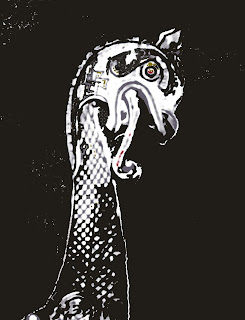
When writing historical novels
with Vikings as central characters there is much scope for where to place a
story. I like to place them in the north-west Highlands because I have enjoyed
so many holidays there. Vikings settled in the northern and western isles and along
the coastline of Scotland from Caithness to Argyle during the early part of the
ninth century. By the middle of that century a Viking kingdom had been set up.
I soon found that research in
this area is sketchy and conclusions were hard to come by. For example,
Laithlinn was the Viking name for Scotland. Laithlinn is also written as
Lothlend, Laithlind and later Lochlainn, and not all scholars believe the name
refers to Scotland. Information in the Irish Annals, the Icelandic Sagas and
Norse histories of South West Norway often contradict each other. Old languages
present further problems and to add to the confusion, writing itself was not
the precise thing it is today. Spelling of names was inconsistent and
punctuation often absent. There are also all the problems of who is writing,
who paid him to do so and how one-sided was the view put forward. In all of
history it is usually the victor who dictates the story.
Scholars continue to argue
about terms such as Dane, Norseman and Viking, who they were and where they
came from, but proof is sadly lacking. Viking itself isn’t really a name, but a
verb; to go “a-viking” was to travel by ship in search of adventure and reward.
It is easy to see how the term became a description of a shipload of hungry men
waving axes.
The
first systems of writing developed and used by the Germanic peoples were runic
alphabets and the runes that were carved in stone still exist. Paper evidence of the period is
almost none existent. When Edward I invaded in 1296 he ordered all the symbols
of Scots nationhood removed to London. A treaty provided for the return of the
records but they remained in London until 1948. Only about 200 documents
remained.
The archives had an unlucky
life. The records that built up after Edward’s time remained safe in the Castle
until its capture by Cromwell's army in December 1650, when they were removed
to Stirling Castle. When Stirling fell in 1651, the records were carried off by
the garrison, or sent to London. Some were returned in 1657, other were sent
back in 1660, but the 'Elizabeth', one of the two ships carrying the archives,
sank in a storm off the Northumbrian coast.
The surviving records were
deposited again in Edinburgh Castle then transferred in 1662 to the Laigh Hall on
the Royal Mile. Damaged by damp and vermin, the great fire of 1700 saw them
removed to St Giles Church. Eventually they were given a safe and permanent
home, but early records pre 1296 are almost non-existent. The King lists
survive, but little else.


No comments:
Post a Comment